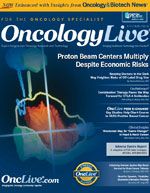Need for Dynamic, Predictive Biomarkers Remains Pressing
Despite advances, the majority of patients receiving targeted therapies do not experience radiographic responses, and nearly all patients who initially benefit develop resistance in less than two years.
Joshua M. Lang, MD
Assistant Professor of Medicine
University of Wisconsin Carbone Cancer Center
The last 10 years have shown tremendous advances in the development of targeted therapeutics for patients with advanced cancer. Ranging from androgen receptor (AR) targeted agents in prostate cancer to EGFR and VEGF targeting in lung cancer, patients are living longer with a better quality of life.
Despite these advances, the majority of patients receiving targeted therapies do not experience radiographic responses, and nearly all patients who initially benefit develop resistance in less than two years. Given these challenges, the need to tailor treatment recommendations has never been greater.1 This personalization requires predictive biomarkers that identify patients most likely to benefit from targeted therapies and pharmacodynamic biomarkers that evaluate if these agents are actually inhibiting the specified pathway. Such biomarkers would have even greater impact if they could identify emerging mechanisms of resistance that help tailor subsequent treatment strategies to these resistant tumors.2
Successful development of predictive and pharmacodynamic biomarkers requires frequent sampling of tumor cells prior to, and throughout, the course of therapy. There is clear evidence that patients with non-small cell lung cancer benefit from serial tumor assessments that evaluate EGFR mutation status and tumor histology.3 Recent biopsy studies in prostate cancer found new mutations in the androgen receptor and DNA damage repair pathways that identify new therapeutic strategies.4,5 Currently, there are few tests available to guide physicians to the treatment that would be most effective, initially or at the time of disease progression.
The goal of personalized medicine is to tailor treatments directly to each patient’s disease. This approach requires easy access to cancer cells to test for sensitivity and resistance. Recent research has identified cancer-derived materials in circulation, including tumor cells, exosomes, and cell-free nucleic acids, accessible through a simple blood draw.1,6-10 This area of biomarker research remains in the early stages of clinical development, with only a few technologies licensed by the FDA for clinical care.
Figure 1. Circulating tumor cells from a patient with metastatic prostate cancer. Blue-Nuclear Stain, Red-EpCAM cell surface stain.
For example, enumeration of CTCs in prostate cancer is predictive of benefit from AR targeted therapies and can serve as a surrogate marker for clinical endpoints (see Figure 1).11 However, enumeration does not identify the underlying mechanisms of resistance that develop during treatment with targeted therapies. Antonarakis and colleagues identified expression of the androgen receptor splice variant V7 in CTCs that correlated with resistance to both abiraterone acetate and enzalutamide.12 The clinical utility of this test is now being evaluated in larger clinical trials. Others have reported heterogeneity in nuclear localization of the AR protein in CTCs from patients with castration- resistant prostate cancer.13,14 Another report identified mutations in the AR from cell-free DNA that predicted therapeutic resistance.15 These varied biomarkers reflect the complex mechanisms of resistance that develop in prostate cancer. Importantly, all of these biomarkers move the field from developing prognostic biomarkers to clinically relevant predictive biomarkers for AR targeted therapies.
Advancing these assays into routine clinical care requires two major hurdles to be cleared. The first is completing analytical validation of each assay: developing the standard operating procedures required to conduct an assay across multiple CLIA-certified environments and defining the performance characteristics of the assay.16 Defining the sensitivity and specificity of an assay as reliable and reproducible is needed to meet the requirements for routine clinical practice. With this information, a biomarker can cross the second hurdle in large prospective clinical trials. It is unknown at this time if the circulating biomarkers discussed above will be needed to predict treatment resistance across the tens of thousands of patients with advanced prostate cancer. Innovative biomarker trials tested across multiple therapies using multiple assays, are needed to identify those most relevant for patient care.
It is unclear if these predictive biomarkers reflect driver or passenger alterations in resistant prostate cancer, or even the extent to which the AR signaling pathway continues to drive disease progression. This is critical given that clinicians must decide between the many treatment options that target the AR or target prostate cancer through non-AR dependent mechanisms (radium-223, sipuleucel-T, docetaxel, and cabazitaxel), as well as many others in advanced clinical trials. It is within this context that pharmacodynamic biomarkers that assess activity in the AR signaling pathway would have an immediate impact.
Gene expression analysis from CTCs or exosomes may have greater potential as pharmacodynamic biomarkers that evaluate whether the AR is inducing expression of target genes such as prostatic acid phosphatase, prostate specific membrane antigen, or others.17,18 Standardization of these types of assays is more complex, given the requirements to set assay thresholds that quantify if pathway activation is increasing or decreasing. However, the clinical utility may be that much greater and move the field beyond predictive biomarkers.
Any biomarker that has completed both analytical and clinical validation has great potential for precision medical care. However, the potential for these biomarkers extends beyond directing clinical therapy. These biomarkers may also facilitate identification of the next generation of treatments for resistant prostate cancer. Integration of these distinct endpoints for CTC enumeration, genomic alterations, transcriptomic and protein endpoints facilitate discovery of novel biomarkers or biologic interactions that drive disease progression. Given the heterogeneity in prostate cancer, discovery of unknown alterations driving disease progression can only aid development of new treatments.



